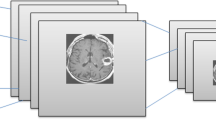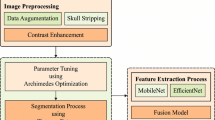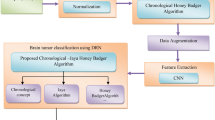Abstract
A brain tumor is the mass of abnormal and unnecessary cells growing in the brain and it is also considered a life-threatening disease. Hence, segmentation and detection of such tumors at an early stage with Magnetic Resonance Image (MRI) is more significant to save the life. MRI is very effective to find persons with brain cancer such that the detection rate of this modality is moderately higher rather than considering other imaging modalities. Due to the size, shape, and appearance variations, the detection of brain tumors is a major complex task in the system of medical imaging. Hence, an efficient brain tumor detection technique is designed using the proposed Improved Invasive Bat (IIB)-based Deep Residual network model. Accordingly, the proposed IIB algorithm is derived by incorporating the Improved Invasive Weed Optimization (IWO) and Bat algorithm (BA), respectively. The segmentation of tumors with MR images has a great impact on detecting the brain tumor at the beginning stage. The deep learning-based method effectively generated better detection results with MR images. With segmentation results, features are acquired from the tumor regions that are further used to make the detection process with the Deep Residual network. However, the proposed method achieved higher performance in terms of the measures, such as accuracy, sensitivity, and specificity by computing the values of 0.9256, 0.9003, and 0.9146, respectively.










Similar content being viewed by others
References
Abdel-Gawad AH, Said LA, Radwan AG (2020) Optimized edge detection technique for brain tumor detection in mr images. IEEE Access 8:136243–136259
Alboliras, E. T., Hijazi, Z. M., Lopez, C. L., & Hagler, D. J. (Eds.). (2018). Visual Guide to Neonatal Cardiology. John Wiley & Sons
Amin J, Sharif M, Raza M, Saba T, Sial R, Shad SA (2020) Brain tumor detection: a long short-term memory (lstm)-based learning model. Neural Comput Applic 32(20):15965–15973
Amin J, Sharif M, Gul N, Raza M, Anjum MA, Nisar MW, Bukhari SAC (2020) Brain tumor detection by using stacked autoencoders in deep learning. J Med Syst 44(2):1–12
Bahadure NB, Ray AK, Thethi HP (2017) Image analysis for mri based brain tumor detection and feature extraction using biologically inspired bwt and svm. Int J Biomed Imag 2017
BRATS (2021) The BRATS dataset was taken from. Available at: https://www.med.upenn.edu/sbia/brats2018/data.html, Accessed on
Chakraborti T, McCane B, Mills S, Pal U (2018) Loop descriptor: Local optimal-oriented pattern. IEEE Signal Process Lett 25(5):635–639
Chen Z, Chen Y, Wu L, Cheng S, Lin P (2019) Deep residual network based fault detection and diagnosis of photovoltaic arrays using current-voltage curves and ambient conditions. Energy Convers Manag 198:111793
Dolz J, Laprie A, Ken S, Leroy H-A, Reyns N, Massoptier L, Vermandel M (2016) Supervised machine learning-based classification scheme to segment the brainstem on mri in multicenter brain tumor treatment context. Int J Comput Assist Radiol Surg 11(1):43–51
Dong H, Yang G, Liu F, Mo Y, Guo Y (2017) Automatic brain tumor detection and segmentation using u-net based fully convolutional networks. In: Annual conference on medical image understanding and analysis. Springer, pp 506–517
Ebrahimzadeh R, Jampour M (2014) Efficient handwritten digit recognition based on histogram of oriented gradients and svm. Int J Comput Appl 104(9)
Erickson BJ (2019) Deep learning and machine learning in imaging: Basic principles. In: Artificial intelligence in medical imaging. Springer, pp 39–46
Figshare (2021) The Figsahre dataset was taken from. Available at: https://figshare.com/articles/brain-tumor-dataset/1512427 Accessed on
Gokulkumari G (2020) Classification of brain tumor using manta ray foraging optimization-based deep cnn classifier. Multimed Res 3(4)
Gopal A (2020) Multimedia research (mr)
Havaei M, Davy A, Warde-Farley D, Biard A, Courville A, Bengio Y, Pal C, Jodoin P-M, Larochelle H (2017) Brain tumor segmentation with deep neural networks. Med Image Anal 35:18–31
Kumar DM, Satyanarayana D, Prasad MG (2021) Mri brain tumor detection using optimal possibilistic fuzzy c-means clustering algorithm and adaptive k-nearest neighbor classifier. J Ambient Intell Human Comput 12(2):2867–2880
Laur O, Wang B (2021) Musculoskeletal trauma and artificial intelligence: current trends and projections. Skelet Radiol 1–13
Misaghi M, Yaghoobi M (2019) Improved invasive weed optimization algorithm (iwo) based on chaos theory for optimal design of pid controller. J Comput Design Eng 6(3):284–295
Saba T, Mohamed AS, El-Affendi M, Amin J, Sharif M (2020) Brain tumor detection using fusion of hand crafted and deep learning features. Cogn Syst Res 59:221–230
Sharif M, Amin J, Raza M, Yasmin M, Satapathy SC (2020) An integrated design of particle swarm optimization (pso) with fusion of features for detection of brain tumor. Pattern Recogn Lett 129:150–157
Tanzi L, Vezzetti E, Moreno R, Aprato A, Audisio A, Masse A (2020) Hierarchical fracture classification of proximal femur x-ray images using a multistage deep learning approach. Europ J Radiol 133:109373
Tanzi L, Piazzolla P, Porpiglia F, Vezzetti E (2021) Real-time deep learning semantic segmentation during intra-operative surgery for 3d augmented reality assistance. Int J CARS 16(9):1435–1445
Tirupattur P, Rawat YS, Spampinato C, Shah M (2018) Thoughtviz: Visualizing human thoughts using generative adversarial network. In: Proceedings of the 26th ACM international conference on multimedia, pp 950–958
Toğaçar M, Ergen B, Cömert Z (2020) Brainmrnet: Brain tumor detection using magnetic resonance images with a novel convolutional neural network model. Med Hypotheses 134:109531
Tsolaki E, Svolos P, Kousi E, Kapsalaki E, Fezoulidis I, Fountas K, Theodorou K, Kappas C, Tsougos I (2015) Fast spectroscopic multiple analysis (fasma) for brain tumor classification: a clinical decision support system utilizing multi-parametric 3t mr data. Int J Comput Assisted Radiol Surg 10 (7):1149–1166
Wang W, Bu F, Lin Z, Zhai S (2020) Learning methods of convolutional neural network combined with image feature extraction in brain tumor detection. IEEE Access 8:152659–152668
Windisch P, Weber P, Fürweger C, Ehret F, Kufeld M, Zwahlen D, Muacevic A (2020) Implementation of model explainability for a basic brain tumor detection using convolutional neural networks on mri slices. Neuroradiology 62(11):1515–1518
Xu Y, Li Z, Wang S, Li W, Sarkodie-Gyan T, Feng S (2021) A hybrid deep-learning model for fault diagnosis of rolling bearings. Measurement 169:108502
Yang X-S (2010) A new metaheuristic bat-inspired algorithm. In: Nature inspired cooperative strategies for optimization (NICSO 2010). Springer, pp 65–74
Author information
Authors and Affiliations
Corresponding author
Ethics declarations
Conflict of Interests
-
1.
The authors have no relevant financial or non-financial interests to disclose.
-
2.
The authors have no competing interests to declare that are relevant to the content of this article.
-
3.
All authors certify that they have no affiliations with or involvement in any organization or entity with any financial interest or non-financial interest in the subject matter or materials discussed in this manuscript.
-
4.
The authors have no financial or proprietary interests in any material discussed in this article.
Additional information
Publisher’s note
Springer Nature remains neutral with regard to jurisdictional claims in published maps and institutional affiliations.
Rights and permissions
Springer Nature or its licensor holds exclusive rights to this article under a publishing agreement with the author(s) or other rightsholder(s); author self-archiving of the accepted manuscript version of this article is solely governed by the terms of such publishing agreement and applicable law.
About this article
Cite this article
Gupta, V., Bibhu, V. Deep residual network based brain tumor segmentation and detection with MRI using improved invasive bat algorithm. Multimed Tools Appl 82, 12445–12467 (2023). https://doi.org/10.1007/s11042-022-13769-0
Received:
Revised:
Accepted:
Published:
Issue Date:
DOI: https://doi.org/10.1007/s11042-022-13769-0




